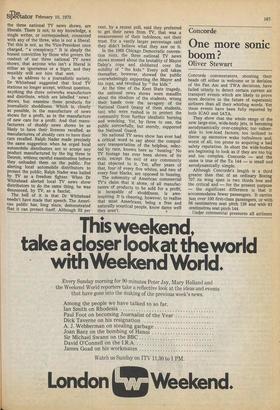Concorde
One more sonic boom?
Oliver Stewart
Concorde commentators, shouting their heads off either in welcome or in derision of the Pan Am and TWA decisions, have failed utterly to detect certain current air transport events which are likely to prove more decisive to the future of supersonic airliners than all their whirling words. Yet these events have been fully reported by both ICAO and IATA.
They show that the whole range of the new large-size, wide-body jets, is becoming aerodynamically over-complex; too vulnerable to low-load factors; too inclined to throw up excessive wake turbulence and, worst of all, too prone to acquiring a bad safety reputation. In short the wide-bodies are beginning to look as if they are too big and too complex. Concorde — and the same is true of the Tu 144 — is small and aerodynamically simple.
Although Concorde's length is a third greater than that of an ordinary Boeing 707 its wing span is two thirds less and the critical and — for the present purpose — the significant difference is that it accommodates fewer passengers. It carries just over 100 first-class passengers, or With 86 centimetres seat pitch 128 and with 81 centimetres seat pitch 144.
Under commercial pressures all airliners are stretched. Profitability for the airline goes up as passengers are packed in more closely. There are schemes for carrying 700 passengers in the 747 and the 1,000 passenger arrangement is not far away.
But Concorde, however stretched and however stuffed, will never carry a load of more than about a quarter of the load which will be carried by the wide-bodies.
At first sight a disadvantage, we now find that it may be the opposite. The break-even load factor for the wide bodies is higher than for the Concorde and it is more difficult to attain. In practice bigness may not always be best. High frequencies in small fast aeroplanes may prove better than low frequencies in slow large aeroplanes.
More disturbing and more critical are the safety factors. Obviously the faster the aircraft the less time the passenger is exposed to risk for a given mileage. And passengers — despite the publicity of the airlines — are interested in their life time
and not in their life mileage. But whether the effect is rational or not it is
established that we become more worried about air safety when large numbers of people are killed in a single crash.
We are disturbed when 180 lose their lives at one swoop. It is, we may be sadly certain, but a small beginning if the airlines retain their passion for the wide bodies. In course of time there is likely to be — there must be — a crash in which 300 or 400 people will be killed.
Nor does a study of large airliner development give any reason for thinking that the risk is being reduced. All modern airliners are boxes of tricks. Concorde is an enormously complicated box of tricks. But the wide-bodies are bigger boxes of tricks and in the vital, basic, decisive region of aerodynamics Concorde, is classically simple while the wide-bodies are frantically complicated.
Some of the Concorde commentators of the past week might have been saved from some of their sillier mistakes had they taken the trouble to look up a paper read before the Royal Aeronautical Society in December 1971 by Sir Morien Morgan of the Royal Aircraft Establishment. He explained that the ogival wing shape of Concorde had, by virtue of that shape, enabled expensive and untrustworthy (the Trident crash) high lift gadgets such as lift engines, flap blowing, slots, slotted flaps, droops and the rest of it to be dispensed with while, at the same time, it had eliminated the stall which was the cause of most serious air accidents since the start of aviation.
Concorde's ogival wing is, without question, the greatest and most important aerodynamic simplification in the whole story of heavier-than-air flight. Contrast it with the almost incredible complication — the polite term is ' sophistication ' — of the Tristar's control arrangements which now include a 'flying stabiliser' which is augmented by linked elevators for pitch control and trim.
With all their gadgetry the wide-bodies do not succeed in achieving a safer flight regime at the critical take-off and landing moments than does Concorde. Concorde's threshold speed is about 155 knots and touch down 152 knots. These are in about the speed range of the subsonic wide
bodies but once off the ground the Concorde can command speeds more than double theirs.
There is also the wake turbulence effect of the wide-bodies now being studied by International Air Transport Association (I.ATA) specialists. It seerns that they can so churn up the air that aircraft following too close may be capsized by the wake
vortices. This, however, is an incidental
defect of the wide bodies. Their basic defects are complication and bigness.
Because it is aerodynamically simple and because it is small in passenger carrying capacity, the Concorde may be in a better position to compete with the subsonic airliners than has yet been appreciated.



































 Previous page
Previous page